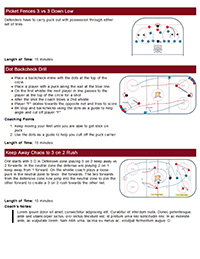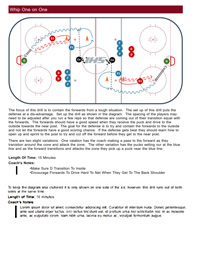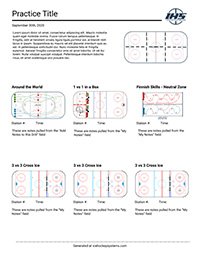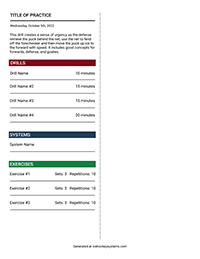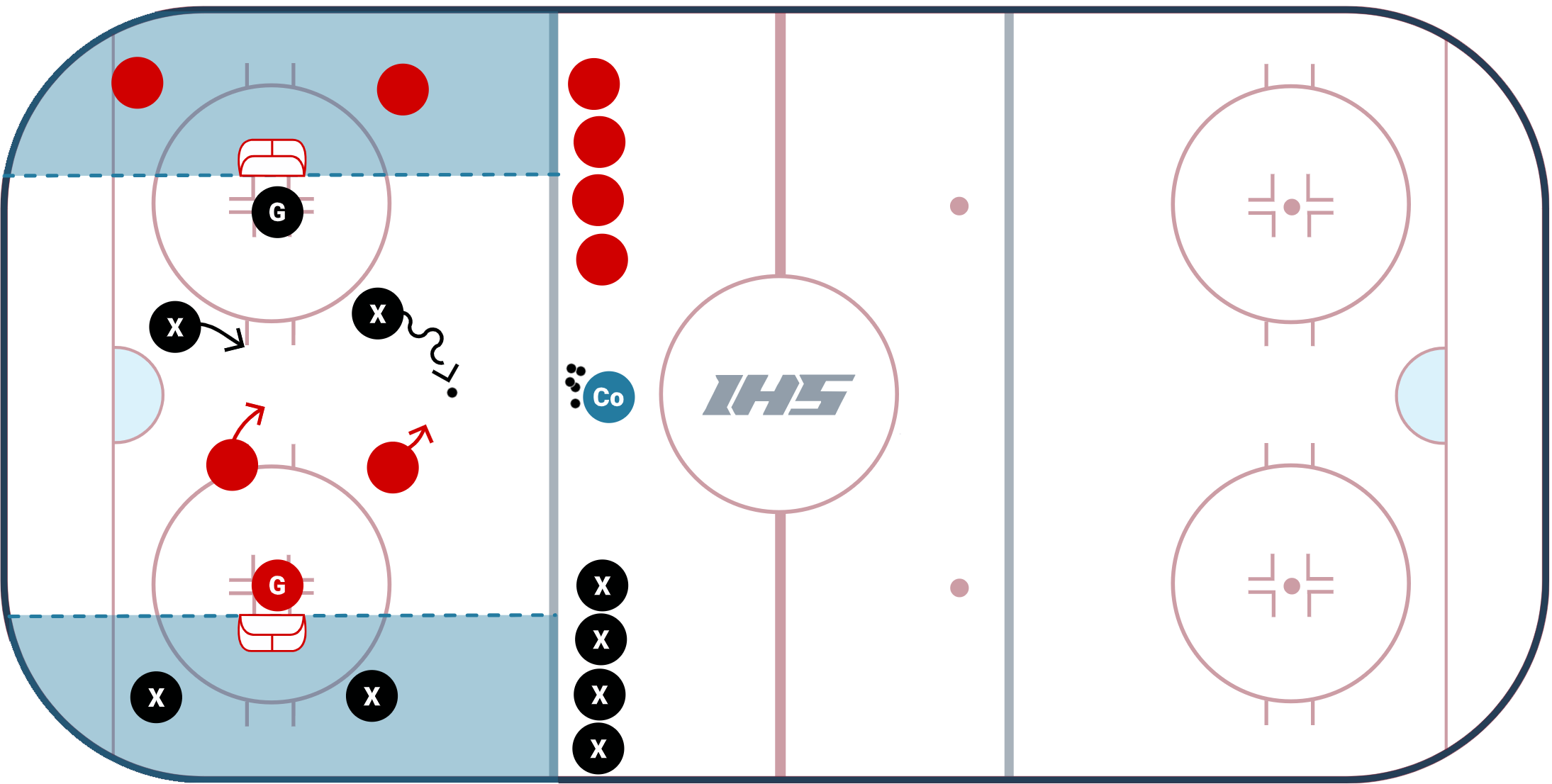
Net Front & Down Low Play
Net Front & Down Low Play
Please Note: The Practice of the Week is usually designed to be utilized across multiple age levels. With that being said, we highly encourage you to adjust the drills based on your team's age and skill levels. These drills and practices can be modified to become more basic or more advanced.
Practice Theme: The drills in this practice are designed to help your players practice and develop net front & down low skills. This practice can be full-ice or half-ice.
Offensive Coaching Points:
- Get to the front of the net: getting to the front of the net is not always easy but it will create screens & chaos for the goaltender. Plus you will have the opportunities for rebounds!
- Find soft space: find soft areas around the net where there is open ice for you, and your stick. This will allow your teammates to get the puck to you.
- Be ready for tips, deflections & rebounds: when you are in front of the net, be ready to react quickly to the puck.
- Awareness: constantly scan the ice to be aware of where the puck, open space, and other players are.
Defensive Coaching Points:
- Communicate: communicate with your defense partner, and be ready to support them.
- Keep sticks on the ice: use an active stick to block passing lanes, lift sticks, and poke check.
- Body positioning: work to be between the puck carrier and net. Do not get stuck along the boards, or cheating to one side.
- Awareness: constantly scan the ice to be aware of where the puck, open space, and other players are.
Protect The Puck Warm-Up (Individual & Team)
This is a fun dynamic warm-up that helps coaches jump-start practice with a competitive puck protection exercise, followed by a competitive team puck possession exercise. Depending on the age and skill level of your players, coaches can modify this drill to make it easier by adding more pucks, or reducing the number of players involved. Scroll to the bottom of this description and you can view examples of how to make these exercises a game (which makes it very fun for younger players).
Setup
Part # 1: Individual Puck Protection
- Split up your team into two groups. If you have full ice, each group can play in their own offensive zone. If you have half ice, one larger group can play in the zone, and the second group can play in the neutral zone.
- On the whistle, a coach chips in a limited number of pucks for players to battle over. In the video, there were 3 pucks used for 10 players. Coaches can add more pucks to make it easier for the players or for younger age groups. Play this out for a minute or so before you switch to a second group or move to Part # 2 of the drill.
Part # 2: Team Keep Away
- The coach combines the groups so there are now two teams playing inside one zone.
- On the whistle, the coach chips in a limited number of pucks for players to battle over. In the video, there were 2 pucks used for the two teams.
Variations
- Make it easier: add more pucks or reduce the number of players.
- Ice space: Can set this up in different areas of the ice.
- Players: Can use your whole team at once or split up into groups so players get a rest.
- Gamify: Can make drill into a very fun competitive game by playing Finders Keepers (players are knocked out of each round if they do not have a puck when time is called) and Finders Keepers With Teams (the team with the most pucks at the end when time is called wins).
Coaching Points
- Part #1:
- If you have the puck, work to protect it with your body and by keeping your head up so you can skate to space, or cut back to create space.
- If you do not have the puck, keep your stick on the ice and compete to get the puck back.
- Part # 2:
- If your team has the puck, keep your head up so you can utilize give & gos!
- If your team does not have the puck, keep your stick on the ice to take away passing lanes and compete to get the puck back.
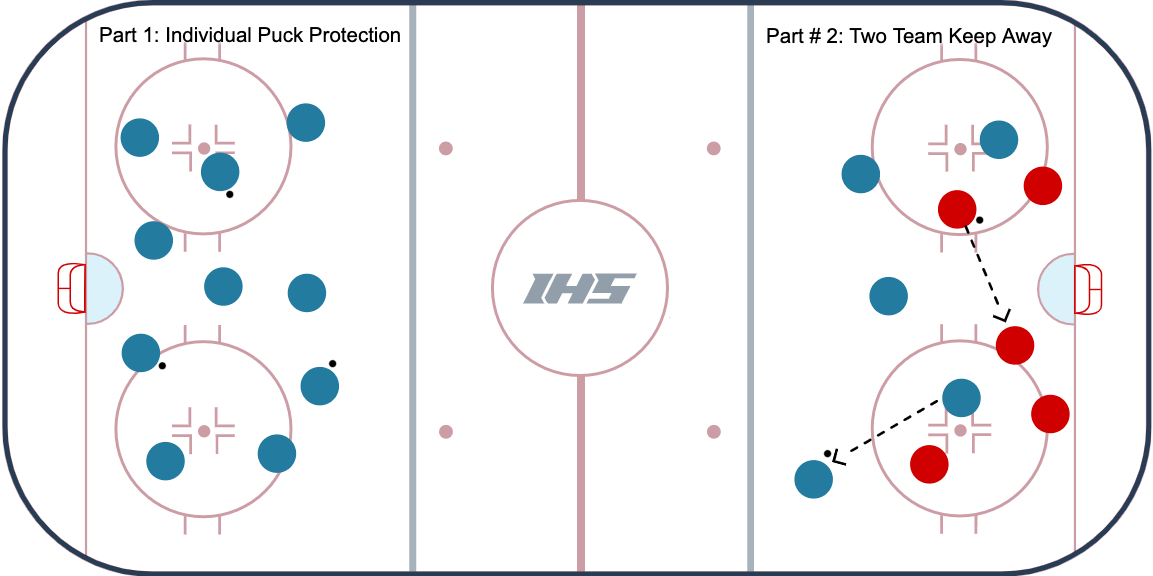
Laker 3 Puck
Player behind net passes pucks to teammates at net front. Defenders must put puck below the goal line or pass to a coach on the dots. On whistle, go to next puck. 3 pucks per rep.
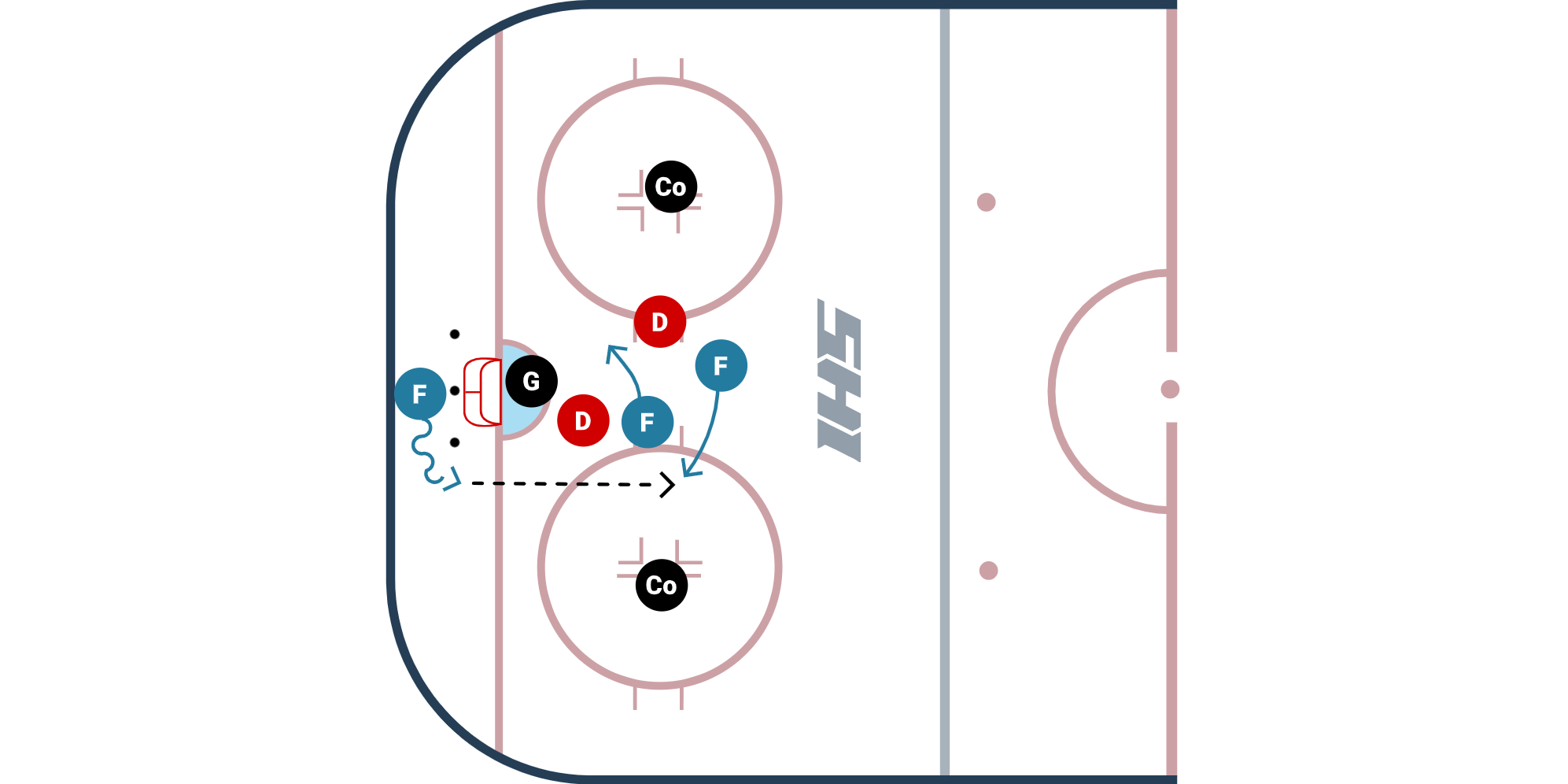
Laker 3 Puck was shared by TJ Manastersky, the current Head Coach at Brock University. It is a high tempo net front / down low drill where the forward behind the net has 3 pucks (as pictured in the diagram).
On each whistle, the player behind the net tries to pass to the 2 forwards in front of the net so they can score. The defenders work to break up the play and must put puck below the goal line or pass to a coach on the dots.
4 v 2 Down Low Game
The 4 v 2 down low game from Kendall Coyne Schofield works on players create opportunities without the puck by using their positioning and getting to open ice in scoring areas
Set Up
- Net with goalie in the normal crease
- 2 stationary forwards flanked to the side of the net, but behind the goal line
- 2 forwards and 2 defensemen in the playing area
- Playing area is from the tops of the circles down
- Coach with pucks standing slightly behind the center of the tops of the circles
- 1 puck at a time in the playing area
Game
The objective is for the forwards to score and the defensemen to clear the puck. Point(s) can be awarded for goals and/or clears.
- Coach starts the game by passing the puck to one of the stationary players behind the goal line
- The stationary players can't go above the goal line, but can pass into the playing area or to the other stationary player behind the net
- The F's and D in the playing ares battle for open space with the forwards trying to support the puck and score and the defensemen trying to defend and clear the puck
- When a puck is cleared, the coach can pass another puck to the stationary players behind the goal line
- Coach can let the game play our as long as he or she sees fit or until a goal is scored
- Keep Score!
Variations
- You can replace or add two stationary players up high at the top of the circle for high passes
- This allows for high tips, screens, deflections and finding different ways to get open and support the puck
- You can have stationary players only up top or add them in along with the stationary players below the goal line
- You can make the defensemen skate or pass the puck through a gate to score a point instead of just clearing the puck
Coaching Points
- Create opportunities without the puck - the forwards can work on losing their defensemen by jumping to open areas of the ice when the environment allows for it.
- Scan the Ice - all players in this game are required to scan the ice and process the information being provided to them to make the necessary decisions when trying to score or defend
- Body Position - defensemen need to keep proper body position on the forwards and make sure they don't allow them into high danger scoring areas
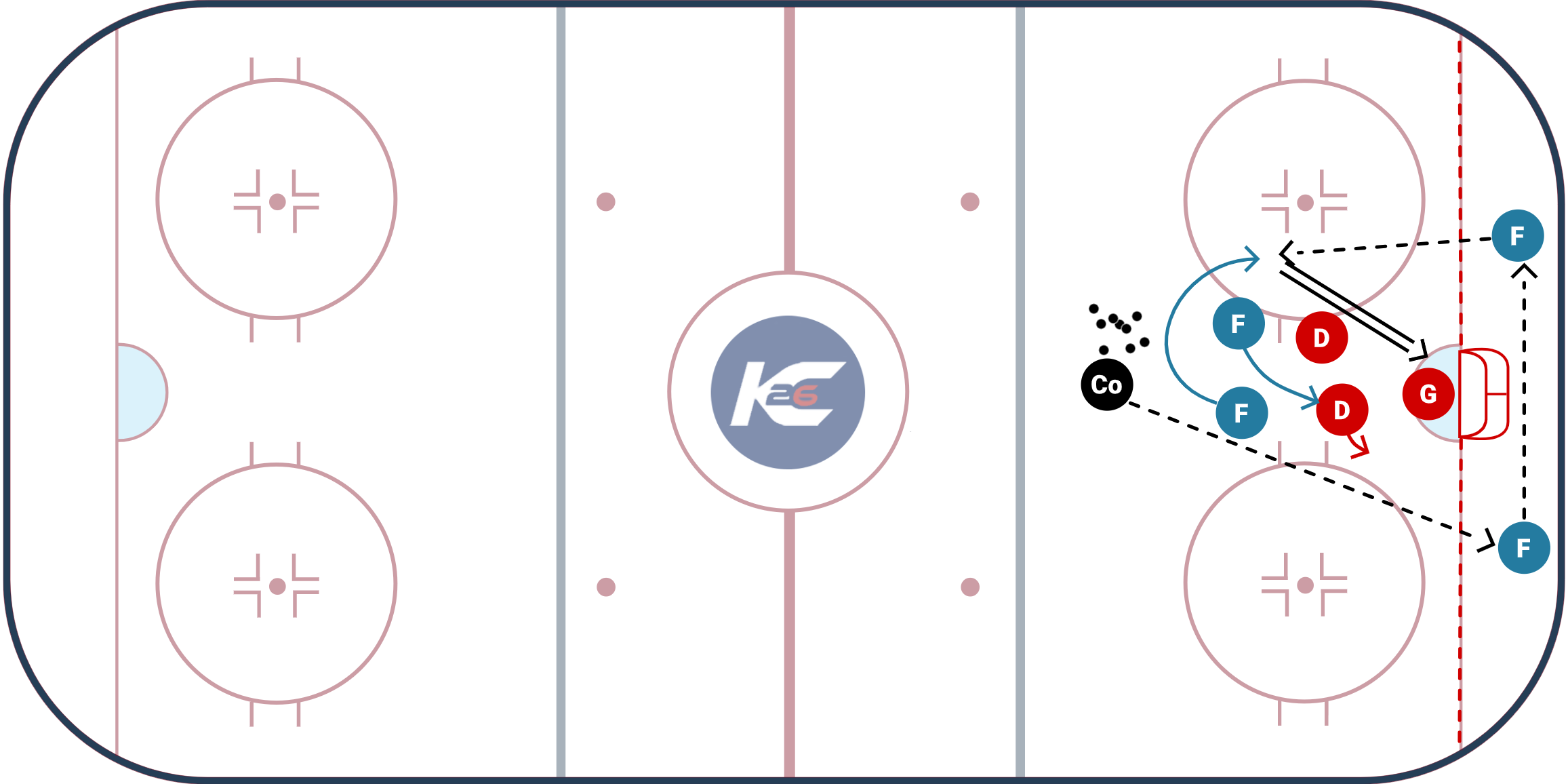
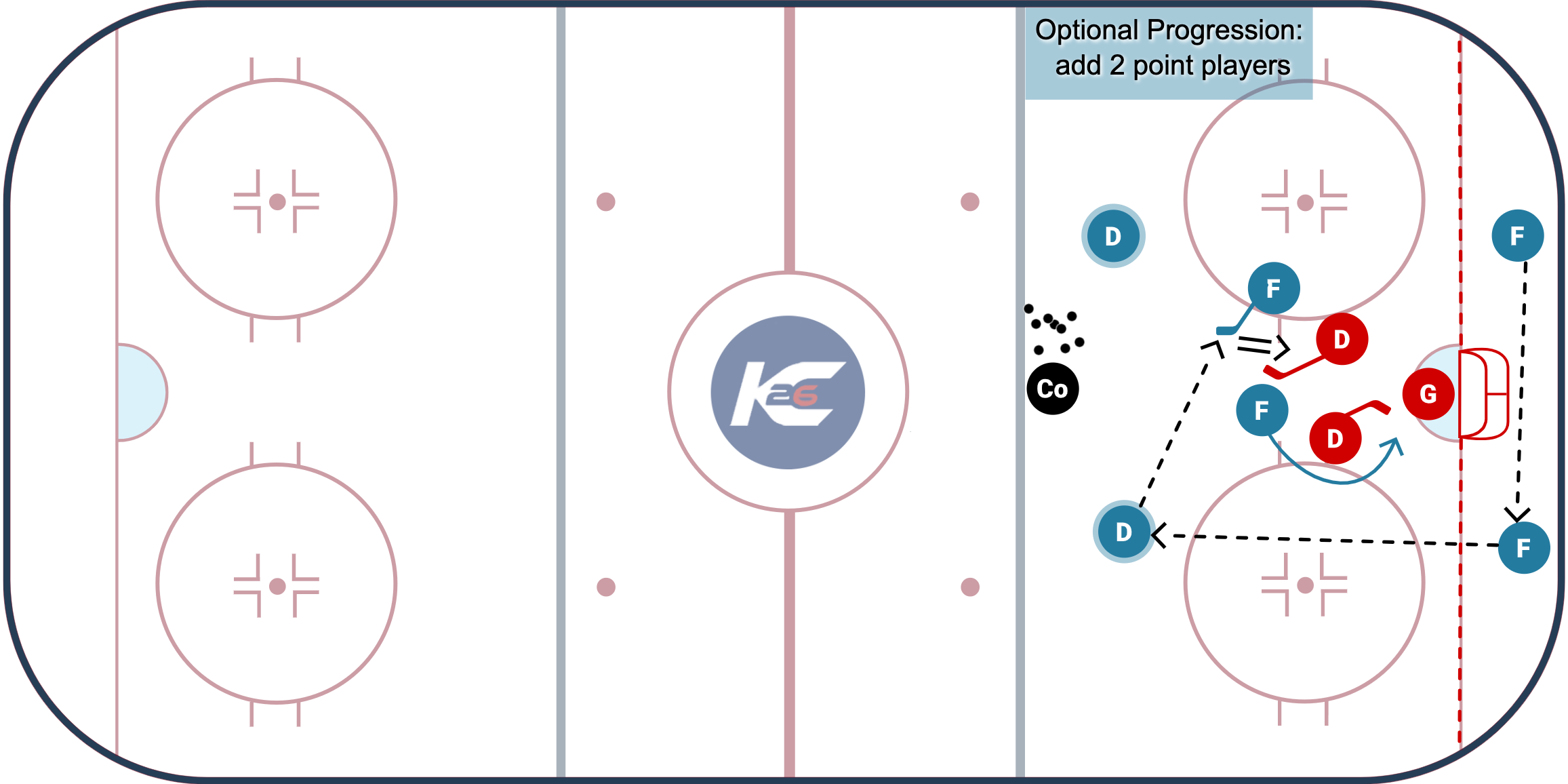
Start with 4 v 2 Down Low, and if coaches want, teams can progress to add 2 point players so it becomes a 6 v 2.
The emphasis of the 4 v 2, and the 6 v 2 is for the net front players to get open and find space so they can be an outlet for their teammates at the point or behind the net.
3 vs. 3 Split Zone Game
3 vs. 3 Split Zone Game is a great small area hockey game to practice offensive and defensive principles that occur during the course of a game. The zone is split in half (as shown in the diagram and video) and the forwards are trying to score a goal, while the defense is defending and trying to exit the zone. The defense must complete one pass before exiting the zone.
Setup
- Split the zone in half (like it is shown in the diagram and whiteboard video)
- 3 offensive players vs. 3 defensive players. One goalie.
- The coach chips the puck to the goalie, who deflects the puck into the corner of the ice. This begins the 3 vs. 3.
- Forwards work to score a goal (which is 2 points) and the defenders work to defend and exit the zone. Defenders must complete one pass before they exit the zone (which is 1 point).
- The game ends when a goal is scored, the defense exits the zone after a pass, the goalie freezes the puck or the coach blows the whistle.
Coaching Points
- Offense:
- Protect the puck.
- Create time and space.
- Use the boards to protect the puck and make bank passes.
- Be a passing outlet for your teammate.
- Defense:
- Sticks on the ice (to angle and block passing lanes).
- Communicate with each other.
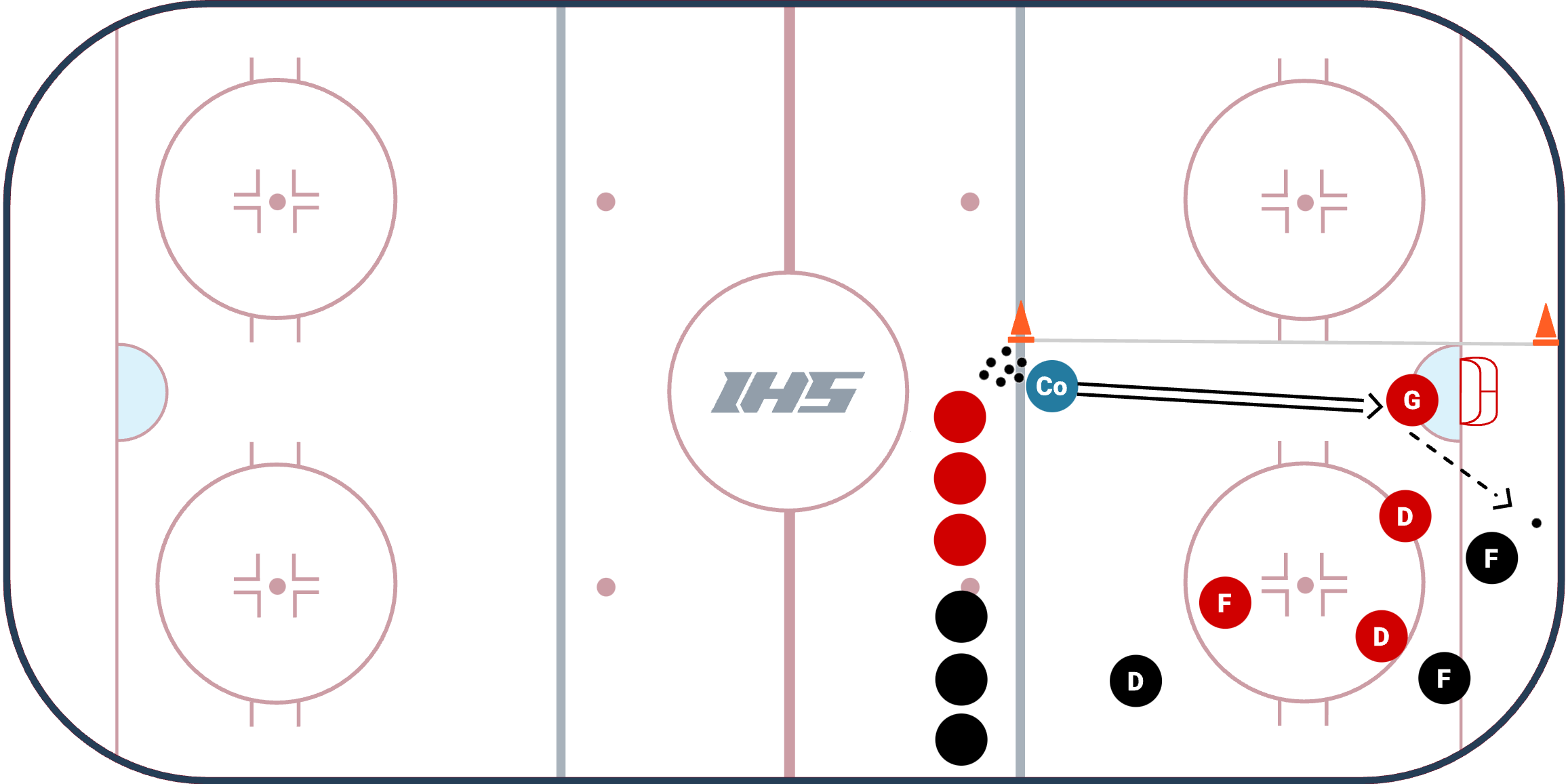
2 On 2 Jets
The 2 on 2 Jets From Todd Knott is an excellent drill that practices 2 on 2's and net-front battles. There are two parts to this drill. Part 1 is a 2 on 2 that is set up as a rush and the drill continues to part 2, which is a 2 on 2 net-front battle. Plus in part 2 of the drill, the forward team has 2 additional forwards and 2 additional defencemen that are activated that can pass and shoot the puck.
Setup:
- There are 2 parts to this drill:
- Part 1: 2 on 2 Rush: On the whistle, the first part begins and is a 2 on 2 where two forwards and two defensemen race to the blue line from the corners. From there the forwards receive a puck from a coach in the corner, which begins the first 2 on 2. After that rush plays out, the coach will blow a whistle.
- Part 2: 2 on 2 Net Front Battle (with support): On the second whistle, the second forwards (the two F2's) and the second defenceman (the two D2's) will activate and be on the offensive team. This will essentially create a 6 on 2 but the focus will be on the 2 on 2 battle in front of the net. The forward in the corner with the group of pucks will put a puck in play with each whistle from coach. Coach will whistle for a new puck when a puck goes out of play, or the forwards score. The perimeter players will work on passing the puck quickly. The coach can allow up to 4 new pucks during one 30 second rep.
Coaching Points:
- On part 1 of the drill, the forwards should work on different timing and tempo to stagger the defenceman.
- On part 2 of the drill, the forwards need to get their sticks free and protect the puck with their body.
- On part 2 of the drill, the defenceman need to work on playing the body and keeping their sticks on the ice to disrupt passing lanes and the forwards stick.
- The perimeter players need to work on quick passing and shots.


Gretzky 2 vs. 2 Game
The Gretzky 2 vs. 2 Game from Topher Scott is a fun small area hockey game that has one major modification to a normal 2 vs. 2 game: each team has two "Gretzky's" behind the net that they can pass to. These "Gretzky's" behind the net must stay behind the net. The setup of the game allows for a lot of creativity, and give & go's!
Setup:
- In a half ice setup, place two nets facing each other in opposite face off circles.
- Each team has 2 players behind the net in their offensive zone. They can not go in front of the net.
- Have a 2 vs. 2 in the middle of the ice.
- To start, coach can pass a puck, take a shot on net, or chip it in the middle of the ice for a battle.
- Keep score!
Coaching Points:
- Offensive players:
- Players in the middle of the ice: work on give and go's! Pass and get open.
- Players behind the net: know where you want to pass to before you get the puck. Use the net as protection and get creative!
- Defensive players:
- Head on a swivel and know where all of the players are.
- Keep stick on ice to block passing lanes.
Variations:
- Can be 2v2 or 3v3 in the middle of the ice.
- Can allow 1 or 2 "Gretzky's"
- Can require players to only hold the puck for 1 or 2 seconds or a whistle is blown.
Additional Resources
- Skill Development Breakdown - Redirects, Deflections and Tips
- View 100+ Small Area Games
- View 20+ Down Low Drills
IHS Member Resources:
- Developing Defensive Zone Habits - a webinar by Alyssa Gagliardi
- IHS Members can create their own practice plans that look like this. Learn how here.
